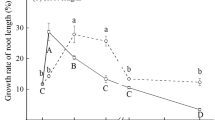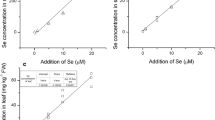Abstract
In an attempt to address the role of biological behavior on Se uptake by soybean crop and the genotype effects, experiments with time and concentration sequences of Se uptake by seedlings in Hoagland solution are conducted using selenite and selenate respectively. Two soybean cultivars Tong-ai 405 (TA) and Qidong Green-skin (QG) are used as different genotypes. In presence of selenite, Se uptake by both roots and shoots exhibited a linear increase with the growing time at 5 μM and with the solution Se concentrations. However, in presence of selenate, the linear response to growing time is only valid before 24 h of growing. While root Se uptake is much slower under selenate than under selenite in the time sequence experiment, shoot Se levels are similar between the two different Se form treatments. Nevertheless, in the experiment of concentration sequence, either root Se or shoot Se responses linearly to solution Se concentration regardless of the Se forms supplied. A big discrepancy of root Se level with a similarity of shoot Se between the two cultivars is observed in the concentration sequence experiment. This supports a much faster passive uptake of selenite but more or less an active uptake of selenate by soybean seedlings. Comparatively, cultivars TA have a consistently higher Se concentration than QG both in roots and shoots under selenate, while no difference of concentration ratio of shoot to root is recognized between them. The higher Se level in seed grains, therefore, may be accounted for not by Se transport form root to shoot but by greater ability of Se uptake and retention under selenate by the former cultivar. Therefore, not only forms of Se supply but also genotype difference affects the Se bioavailability by different soybean cultivars. This should be taken into account for screening the high Se-efficiency plants or cultivars to improve the Se supply of the food chain.
Similar content being viewed by others
References
Anderson J W 1993 Selenium interactions in sulfur metabolism. In Sulfur Nutrition and Assimilation in Higher Plants: Regulatory, Agricultural and Environmental Aspects. Ed. LJ De Kok. pp. 49–60. SPB Academic Publishing, The Hague, The Netherlands.
Aro A, Alfthun G and Varo P 1995 Effect of supplementation of fertilizer on human selenium status in Finland. Analyst 120, 841–843.
Arvy M P 1989 Some factors influencing the uptake and distribution of selenite in the bean plant (Phaseolus vulgaris). Plant Soil 117, 129–133.
Arvy M P 1993 Selenate and selenite uptake and transport in bean plants (Phaseolus vulgaris). J. Exp. Bot. 44(263), 1083–1087.
Asher C J, Butler G W and Peterson P J 1977 Selenium transport in root systems of tomato. J Exp. Bot 103, 279–291.
Bange G G J 1973 Diffusion and absorption of ions in plant tissue: the role of the root cortex cells in ion absorption. Acta Bot. Neerl. 22, 529–542.
Beeson K C 1961 Occurrence and significance of selenium in plants. In: Agriculture Handbook. U.S. Dept. Agric., Washington, DC. Rep. No. 200, pp 30–40.
De Souza M P, Pilon-Smits E A H and Lytle C M 1998 Ratelimiting steps in selenium assimilation and volatilization by Indian mustard. Plant Physiol. 117, 1487–1494.
Elilig C F, Allway W H, Cary E E and Kubota J 1968 Differences among plant species in Se accumulation from soils low in available selenium. Agron. J 60, 43–47.
Ge K and Yang G 1993 The epidemiology of selenium deficiency in the etiology of endemic diseases in China. An. J. Clin. Nutr. 57, 259–263.
Girling C A 1984 Selenium in agriculture and the environment. Agric. Ecoyst. Environ. 11, 37–65.
Gupta U C and Macloed J A 1994 Effect of various sources of selenium fertilization on the selenium concentration of feed crops. Can. J. Soil Sci 74, 285–290.
Huang AY and Wu ZL 1997 The effects of Na2SeO3 on rice seedling growth and glutathione peroxidase activity. J Southwest China Normal Univ. (Natural Science) 22(4), 421–425 (in Chinese with English abstract).
Hoagland D and Arnon D I 1938 The water culture method for growing plants without soil. Bull. Calif. Agric. Stations 346.
Ip C 1998 Lessons from basic research in selenium and cancer prevention. J Nutr 128, 1845–1854.
James L F, Mayland H F, Miller M R and Panter K E 1989 Selenium poisoning in livestock: a review and progress. In Selenium in Agriculture and the Environment. Ed. L W Jacobs. pp. 123–131. SSSA Madison, WI.
Leggett J E and Epstein E 1956 Kinetics of sulfate adsorption by barley roots. Plant Physiol 31, 222–226.
Levander O A 1982 Selenium: biochemical actions, interactions, and some human health implications. In Clinical, biochemical and nutritional aspects of trace elements. Ed. A S Prasad. pp. 345–368. Elsevier, New York.
Li Z Y, Guo Q Y, and Xu Zh Q 2000 Genotypical differences and characteristics of Se accumulation in soybean. Plant Nutr. Fertil. Sci 6(2), 207–213 (in Chinese with English abstract).
Pilon-Smits E, Hwang S, Lytle C M, Zhu Y, Tai J C, Bravo R C, Chen Y, Leustek T and Terry N 1999 Overexpression of ATP sulfurylase in Indian mustard leads to increased selenate uptake, reduction, and tolerance, Plant Physiol. 119, 123–132.
Smith F W, Hawkesford M J, Prosser I M, et al. 1995 Isolation of a cDNA from Saccharomyces cerevisiae that encodes a high affinity sulphate transporter at the plasma menbrane. Mol. Gen. Genet. 247, 709–715.
Smith F W, Hawkesford M J, Ealing P M, et al. 1997 Regulation of expression of a cDNA rom barley roots encodion a high affinity sulphate transporter. Plant. J. 12, 875–884.
Smith G S and Watkinson J H 1984 Selenium toxicity in perennial ryegrass and white clover. New Phytol. 97, 557–564.
Terry N, Zayed A M, de Souza M P and Tarun A S 2000 Selenium in plants. Annu. Rev. Plant Physiol. Mol. Biol 51, 401–432.
Wang Z J, Xie S and Peng A 1996 Distribution of Se in soybean samples with different Se concentration. J. Agric. Food Chem 44, 2754–2759.
Yamada H, Kang Y, Aso T, et al. 1998 Chemical forms and stability of selenium in soil. Soil Sci. Plant Nutr. 44(3), 385–391.
Yang F Y and Wu W H 1988 Role of selenium in stabilization of human erythrocyte membrane skeleton. Biochemistry 15, 475–482.
Zhang Y, Pan G, Chen J, et al. 2002 Effect of genotype on selenium uptake and accumulation by soybean in low-Se soils. Soybean Science 21(4), 263–267 (in Chinese).
Zhou W M 1998 Influence of applying selenium on some biochemistry properties and selenium level in rice. J. Mountain Agric. Biol 17(6), 323–326 (in Chinese with English abstract).
Author information
Authors and Affiliations
Corresponding author
Rights and permissions
About this article
Cite this article
Zhang, Y., Pan, G., Chen, J. et al. Uptake and transport of selenite and selenate by soybean seedlings of two genotypes. Plant and Soil 253, 437–443 (2003). https://doi.org/10.1023/A:1024874529957
Issue Date:
DOI: https://doi.org/10.1023/A:1024874529957




